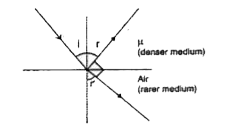A) Statement Iis True, Statement II is True, Statement II is a correct explanation for Statement I
B) Statement Iis True, Statement II is True, Statement II is not a correct explanation for Statement I
C) Statement Iis True, Statement II is False.
D) Statement I is False, Statement II is True.
Statement I : A ray of light incident on the interface of a dense medium (μ) and a rater medium (air), is partially reflected at an angler and partially refracted at an angle r'. If the angle between the reflected and refracted rays is 90° then the critical angle is sin−1tanr'.
Statement II : The refractive index of the denser medium is inversely proportional the sine of the critical angle.
Statement I is True, Statement II is True, Statement II is a correct explantion for Statement I.
Statement I is True, Statement II is True, Statement II is not a correct explantion for Statement I.
Statement I is True, Statement II is False.
Statement I is False, Statement II is True.
The correct Answer is:D
If I and r. are the angle of incidence and reflection then μsini=sinr.

The angle of incident for which the angle of refraction is 90∘ is called the critical angle (i). Thesefore
μ=1sinic
From the diagram r+r.=90∘
If μ=sinr.sinr=sin(90−r)sinr=cotr
Also μ=1sinic=cotr
⇒sinic=tant⇒ic=sin−1tanr
Also μ=sinr.sinr=tanr.andic=sin−1cotr.
The reason is correct but the assertion is wrong. These is a max-up of angle, the correct expression are ic=sin−1tanr.andic=sin−1cotr.
Similar Questions
This question has statement-I and statement-II of the four choices given after the statement.Choose the one that best describes the two statements
Statement-I is true Statement-II is true Statement-II is a correct explanation of statement-I
Statement-I is true Statement-II is true Statement-II is not a correct explanation of statement-I
Statement--I is true , Statement-II is false
Statement-I is false statement-II is true
Both statement-I and statement-II are false
Statement - I : The acceleration of a particle in uniform circular motion is constant in magnitude.
Statement- II : The particle experiences centripetal force in uniform circular motion.03:10View SolutionThis question has statement-I and statement-II of the four choices given after the statement.Choose the one that best describes the two statements
Statement-I is true Statement-II is true Statement-II is a correct explanation of statement-I
Statement-I is true Statement-II is true Statement-II is not a correct explanation of statement-I
Statement--I is true , Statement-II is false
Statement-I is false statement-II is true
Both statement-I and statement-II are false
Statement - I : If a body moving in a circular path has constant speed, then there is no force acting on it.
Statement- II : The direction of the velocity vector of a body moving in a circular path is changing.02:42View SolutionThis question has Statement l and Statement II. Of the four choices given after the Statements, choose the one that best describes the two Statements. Statement - I : The brightnss of a light bulb in a room decreases when a heavy current appliance is switched on Statement - II : There will be no charge in brightness of bulb if the source is ideal. (1) Statement - I : true, Statement - II is true, Statement - II is a correct explanation of Statement -I (2) Statement -I is true, Statement -II is true, Statement - H is not a correct explanation of Statement -1. (3) Statement - I : is true, Statement - II is false. (4) Statement - I : is false, Statement - II true. (5) Statement - I is false, Statement - II false.
View SolutionAssertion: Minimum number of non-equal Vectors in a plane required to give zero resultant is three.
Reason: If →A+→B+→C=→0, then they must lie in one plane
A. Statement-I is true, Statement-II is true, Statement-II is correct explanation for statement-I
B. Statement-I is true, Statement-II is true, Statement-II is NOT a correct explanation for statement-I
C. Statement-I is true, Statement-II is false.
D. Statement-I is false and Statement-II is true.02:35View SolutionStatement-I : The angle between vectors vec(A)xxvec(B) and vec(B)xxvec(A) is pi radian. Statement-II : vec(B)xxvec(A)=-vec(A)xx vec(B) A. Statement-I is true, Statement-II is true, Statement-II is correct explanation for statement-I B. Statement-I is true, Statement-II is true, Statement-II is NOT a correct explanation for statement-I C. Statement-I is true, Statement-II is false. D. Statement-I is true, Statement-II is false.
02:01View SolutionEach question contains Statement I and II. Of these Statements, mark correct choice if
A) Statements I and II are true and Statement II is a correct explanation for Statement I
B) Statements I and II are true and Statement II is not a corrent explanation for Statement I
C) Statement I is true, Statement II is false
D) Statement I is false, Statement II is true
Statement I : On a rainy day it is difficult to drive a car or bus at high speed.
Statement II : The value of coefficient of friction is lowered due to wetting of the surface.View SolutionA) Statement Iis True, Statement II is True, Statement II is a correct explanation for Statement I
B) Statement Iis True, Statement II is True, Statement II is not a correct explanation for Statement I
C) Statement Iis True, Statement II is False.
D) Statement I is False, Statement II is True.
Statement : Focal length of an equiconvex lens (n=3/2) is equal to radius of curvature of each surface.
Statement II : It follows from, 1f=(n−1)(1R1−1R2)View SolutionA) Statement Iis True, Statement II is True, Statement II is a correct explanation for Statement I
B) Statement Iis True, Statement II is True, Statement II is not a correct explanation for Statement I
C) Statement Iis True, Statement II is False.
D) Statement I is False, Statement II is True.
Statement I : The mirrors used in search lights are parabolic and not concave spherical.
Statement II : In a concave spherical mirror the image formed is always virtual.View Solution

